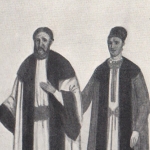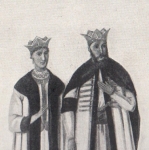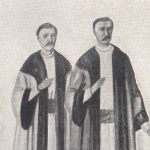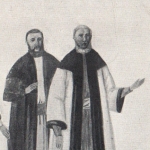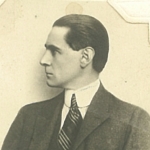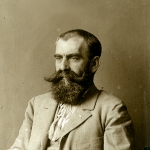 Brief History
Brief History
The Cantacuzinos are one of the oldest noble families in Romania and the Balkans, dating back to as early as the ninth century AD. Over the centuries, the family gave the world great rulers, statesmen, scholars and many other prominent people in various fields of activity.
The following paragraphs represent a brief overview of the most important milestones in the history of the family, its members having been directly involved in key moments in the history of the country and of the region. (for a more comprehensive history of the family, please see the book of Ion Mihai Cantacuzino “O mie de ani în Balcani”(“A thousand years in the Balkans”), Albatros Publishing, 1996).
11th – 12th centuries
In 1094, “… a Vlach chief came to Emperor Alexios (Comnenus) to inform him that the Cumans had crossed the Danube… Then he (the emperor) sent Cantacuzino and other heads, together with foreign troops, to a place called Thermes”. This is the first mention of the Cantacuzino name, found in the Alexiada, written by Anna Comnena between 1137 and 1148 (the name is identified as “Kantakouzenos” in Greek).
13th -14th centuries
In 1262, Mihail Cantacuzino became governor of the Byzantine possessions in the Morea. Half a century later, Ioan Cantacuzino was appointed Grand Domestic of Emperor Andronicus III, and in 1347 he was crowned Emperor under the name of John VI. He abdicated (a rare act in the era) in 1354, after which he retired to a monastery, where “…he wrote the history of his times”.
15th -16th centuries
In 1519, Theodor Spandunino Cantacuzino published in Paris The Genealogy of the Turkish Sultan, currently ruler.
Towards the end of the 16th century, Mihai Cantacuzino (whom the Turks nicknamed Şeytan oğlu, meaning “Son of the devil”) became such an important figure at the Sultan’s Court, that he appointed his brothers-in-law, Alexandru and Peter the Lame, sultans of Wallachia and Moldavia, and relieved and substituted the Patriarch of Constantinople. However, he was killed at the command of the new sultan, Murad III, in 1578. In 1593, his son Andronicus contributed to the appointment of Ban Michael as ruler of Wallachia – better known as Michael the Brave.
17th -18th centuries
As ruler of Wallachia (1679 – 1688), Şerban Cantacuzino built the Cotroceni Monastery (demolished in the ’80s at Elena Ceaușescu’s instruction) and the Șerban-Vodă inn. He also reopened the Patriarchy’s printing press and ordered the Greceanu brothers to print the first Bible in Romanian.
During his rule, Mihai Cantacuzino, built the Sinaia Monastery (opened in 1695), and, in 1704, inaugurated the Colțea Hospital, near the monastery with the same name, also built by him
Pârvu Cantacuzino finished, in 1694, Horezu monastery.
In 1700, Constantin Cantacuzino printed the first map of Wallachia and also started to write a history of Wallachia.
Prince Grigore Cantacuzino fought in the Russian army against Napoleon Bonaparte. Wounded at Austerlitz, he was killed at Borodino. Gheorghe Cantacuzino was also wounded at Friedland.
19th century
After the Revolution of 1848, Constantin Cantacuzino was appointed, for less than one year, kaymakam of Wallachia.
During the War of Liberation from 1877, cavalry officer Paul Cantacuzino distinguished himself in the Russian army, while engineer officer Iancu and nurse Maria Cantacuzino became important names in the Romanian army.
Starting in 1880, Ioana A. Cantacuzino translated and popularized Schopenhauer in French.
In the new kingdom of Romania, Gheorghe Cantacuzino (nicknamed “The Nabob”) became head of the Conservative Party, President of the Senate, and twice head of the Government.
In 1875, Jean Basile Cantacuzino designed and Iancu Cantacuzino finalized the Ploiești-Sinaia-Predeal railway, then the National section in 1882. The first director of the newly established Romanian Railways was Gogu Cantacuzino.
In 1899 was born, in Vienna, George Matei Cantacuzino, who was to become a famous architect, painter and writer
20th century
During World War I, ten Cantacuzinos fought for the Russians. Beginning in 1916, another five were enrolled in the Romanian army.
The Treaty of Trianon was signed by Dr. Ion Cantacuzino and Nicolae Titulescu, from the Romanian side.
During World War II, painter Andronic Cantacuzino was killed in the Battle of the Danube Bend. Raymund Cantacuzino was taken prisoner at Stalingrad, but he would return to Munich after ten years of captivity. Prisoner of the English, Alexander Cantacuzino was lucky to be released in 1946.
In 1948, an aviation ace of the time, Captain Constantin “Bâzu” Cantacuzino fled the country and settled in Spain.
Magistrate Adolf Cantacuzino died at the age of 67, in the camp instituted for the construction of the Danube-Black Sea Canal. Other family members − Ion Gheorghe, Constantin, Dan, and Marie-Ioana − managed to escape from the Communist camps alive.
Currently, the members of the Cantacuzino family can be found in France, USA, Switzerland, Sweden, UK and Romania.
